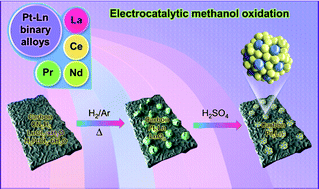Lanthanide electronic perturbation in Pt–Ln (La, Ce, Pr and Nd) alloys for enhanced methanol oxidation reaction activity†
Abstract
Simultaneously achieving high activity and robust stability is still challenging for direct methanol fuel cells in practical applications. Although noble metal Pt has been applied as an electrocatalyst, it still suffers from low stability and high cost, which significantly limits its wide applications on a large scale. Here, a series of Pt–Ln/C (Ln = La, Ce, Pr, Nd) nanoalloy catalysts were synthesized to improve the electroactivity towards methanol oxidation and suppress the CO poisoning effect of Pt. DFT calculations have unravelled the different electronic structures of different Pt5Ln samples, in which the optimal d–f coupling in Pt5Ce leads to significant improvements in both electroactivity and selectivity. Such an electronic structure also effectively suppresses the CO poisoning effect during the MOR. Pt5Ce/C shows the best performance, with a specific activity of 32.74 mA cmPt−2, which is 11.1 times higher than that of commercial Pt/C (2.94 mA cmPt−2). This work demonstrates the critical promotion effect of lanthanide elements in the electroactivity of Pt due to the electronic structure perturbation, which provides new ideas for the design of efficient lanthanide alloy catalysts.

- This article is part of the themed collection: Energy & Environmental Science Recent HOT Articles


 Please wait while we load your content...
Please wait while we load your content...